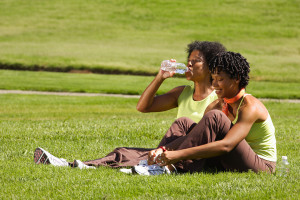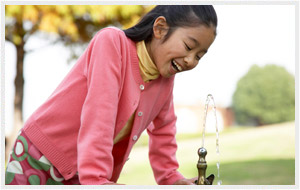 Earlier this month, First Lady Michelle Obama launched a new public health campaign focused on encouraging American families to drink more water. “Drink Up” seeks to reduce obesity in children by sending a positive message about the value of drinking water as a beverage of choice.
Earlier this month, First Lady Michelle Obama launched a new public health campaign focused on encouraging American families to drink more water. “Drink Up” seeks to reduce obesity in children by sending a positive message about the value of drinking water as a beverage of choice.
While not explicitly targeting the sugar-sweetened beverage industry, the campaign aims to encourage people to stock up on water through the day in hopes that they will turn less to sugary drinks to fill their cravings.
The Drink Up logo is to appear on at least 200,000 reusable bottles of water, 500 million bottles, 300 million water bottle packs, and 12,000 water taps. PSA style messaging is being rolled out through online digital ads as well as billboards and public monitors and screens.
The launch event for Drink Up took place on September 12 in Watertown, WI and featured the First Lady, actress Eva Longoria and the Partnership for a Healthier America. More than a dozen companies signed on to Drink Up, agreeing to promote the brand and logo. Among the supporters were several reusable bottle companies, tap manufacturers and bottled water brands.
“I’ve come to realize that if we were going to take just one step to make ourselves and our families healthier, probably the single best thing we could do is to simply drink more water,” stated the First Lady.
Many have praised the First Lady’s efforts to encourage more water consumption, though some have challenged that it doesn’t go far enough in sending a message to drink less soda. Several groups have decried any support for the bottled water industry, complaining that a message about drinking tap water might have been better suited, as the support for bottled water still puts money in the hands of the bottled-drink industry and contributes to landfill waste.
The outcome of the campaign remains to be seen, but it is well-timed to give added impetus to what may be a downward trend in sugary drinks. Just last month, the CDC released a study showing that sugar-sweetened beverage consumption among children may be on the decline. A study assessing focusing on children under age 17 in Los Angeles County showed that children who consumed 1 or more SSB per day decreased from 43.3% in 2007 to 38.3% in 2011.
Another study published in the American Journal of Clinical Nutrition last May showed a decline in consumption of sugar-sweetened drinks in both youth and adults. From 2009 to 2010, youth consumed an average of 155 kilocalories per day (kcal/d) of sugar-sweetened beverages, and adults consumed an average of 151 kcal/d of sugar-sweetened beverages. This was a decline from 1999 to 2000 of 68 kcal/d and 45 kcal/d, respectively.
To learn more about the First Lady’s Drink Up initiative, visit youarewhatyoudrink.org.




